Bai Dinh Pagoda, a sprawling complex in Ninh Binh Province, stands as a testament to Vietnam’s rich Buddhist heritage and architectural grandeur. But How Does Bai Dinh Compare To Other Major Pagodas In Vietnam? SIXT.VN is here to guide you through the highlights of this unique spiritual site, offering convenient travel solutions to make your exploration seamless. Discover Vietnam’s pagoda landscape, cultural sites, and spiritual journeys with us.
1. Understanding Bai Dinh Pagoda: A Modern Marvel
Bai Dinh Pagoda isn’t just one temple; it’s a vast complex comprising both an ancient temple nestled in the mountains and a sprawling, newly constructed area at the foot of the hills. Completed in 2010, the new complex was built to accommodate the increasing number of pilgrims and visitors. It’s known for its record-breaking features and stunning scale. Bai Dinh Pagoda, a key religious landmark, showcases a blend of traditional Vietnamese architectural styles with modern construction techniques, symbolizing a revival of Buddhist culture in Vietnam.
2. What are the Key Features That Set Bai Dinh Apart?
Bai Dinh Pagoda distinguishes itself through several remarkable features:
- Size and Scale: As the largest Buddhist complex in Vietnam, Bai Dinh boasts an immense area dotted with multiple temples, halls, and structures.
- 500 Arhat Statues: A 3-kilometer corridor houses 500 intricately carved Arhat statues, each with unique facial expressions and poses, making it the longest Arhat corridor in Asia.
- Bronze Bell Tower: The pagoda is home to the largest bronze bell in Vietnam, weighing 36 tons, housed in an impressive bell tower.
- Statue of the Thousand-Eyed, Thousand-Armed Guanyin: The complex features a magnificent bronze statue of the Bodhisattva of Compassion, one of the largest in the country.
- Sacred Setting: Situated amidst the stunning natural landscape of Ninh Binh, a UNESCO World Heritage site, the pagoda offers a unique blend of spiritual and scenic beauty.
3. How Does Bai Dinh’s Architecture Reflect Vietnamese Buddhist Traditions?
Bai Dinh Pagoda’s architecture beautifully reflects Vietnamese Buddhist traditions while incorporating modern elements. The complex follows traditional Vietnamese pagoda designs with multi-tiered roofs, intricate carvings, and the use of natural materials like wood and stone. The layout includes various halls dedicated to different Buddhas and Bodhisattvas, reflecting the syncretic nature of Vietnamese Buddhism, which often blends elements of Mahayana Buddhism, Taoism, and local beliefs.
4. How Does Bai Dinh Compare to Other Major Pagodas in Vietnam?
To truly understand Bai Dinh’s significance, let’s compare it to other prominent pagodas in Vietnam:
4.1. Perfume Pagoda (Chua Huong)
- Location: Hanoi
- Significance: A vast complex of temples and shrines built into the Huong Tich mountains, drawing pilgrims during the annual Perfume Pagoda Festival.
- Comparison: Unlike Bai Dinh’s grand structures, Perfume Pagoda is known for its natural cave temples and serene boat rides. It emphasizes a more rustic and adventurous pilgrimage experience.
4.2. One Pillar Pagoda (Chua Mot Cot)
- Location: Hanoi
- Significance: An iconic, small pagoda built on a single pillar in the middle of a lotus pond, symbolizing purity and enlightenment.
- Comparison: In stark contrast to Bai Dinh’s expansive scale, One Pillar Pagoda is celebrated for its simplicity and unique architectural design.
4.3. Thien Mu Pagoda
- Location: Hue
- Significance: A historic pagoda overlooking the Perfume River, known for its seven-story tower and its association with Vietnamese Buddhism’s struggles during the 20th century.
- Comparison: Thien Mu Pagoda blends historical significance with scenic beauty, while Bai Dinh focuses on its record-breaking architectural achievements and spiritual tourism.
4.4. Vinh Nghiem Pagoda
- Location: Bac Giang
- Significance: One of the oldest centers of Buddhism in Vietnam.
- Comparison: In contrast to Bai Dinh, Vinh Nghiem Pagoda stands out for its ancient origin and unique collection of ancient woodblocks, which held immense historical and cultural value.
4.5. Key Differences in a Table
| Feature | Bai Dinh Pagoda | Perfume Pagoda | One Pillar Pagoda | Thien Mu Pagoda | Vinh Nghiem Pagoda |
|---|---|---|---|---|---|
| Size | Largest complex in Vietnam | Extensive mountain complex | Small, iconic structure | Large, historical site | Large, historical site |
| Architecture | Grand, modern with traditional elements | Natural cave temples, rustic | Unique single-pillar design | Traditional, multi-tiered tower | Traditional Vietnamese architecture |
| Focus | Spiritual tourism, record-breaking features | Pilgrimage, natural beauty | Symbolism, simplicity | History, scenic views | Ancient origin, cultural value |
| Setting | Ninh Binh’s karst landscape | Huong Tich mountains | Lotus pond in Hanoi | Perfume River in Hue | Rural setting of Bac Giang |
| Unique Features | 500 Arhat statues, largest bronze bell | Cave temples, boat rides | Single pillar, lotus pond | Seven-story tower, historical context | Ancient woodblocks, historical significance |
5. What Are the Cultural and Spiritual Significance of Bai Dinh?
Bai Dinh Pagoda holds immense cultural and spiritual significance in Vietnam. It revives and promotes Buddhist culture, attracting pilgrims and tourists from across the country and the world. The pagoda serves as a center for Buddhist ceremonies, festivals, and teachings, contributing to the preservation and propagation of Buddhist values. It symbolizes the harmony between nature and spirituality, as its location amidst the stunning karst landscape enhances its serene and sacred atmosphere.
6. How is Bai Dinh Pagoda a Center for Pilgrimage and Tourism?
Bai Dinh Pagoda has become a major center for pilgrimage and tourism in Vietnam for several reasons:
- Religious Significance: As a prominent Buddhist site, it attracts pilgrims seeking blessings, spiritual guidance, and merit.
- Architectural Marvel: Its grand scale and record-breaking features draw tourists interested in cultural and architectural landmarks.
- Scenic Beauty: The pagoda’s location in Ninh Binh, a UNESCO World Heritage site, offers visitors a chance to experience the stunning natural landscape.
- Festivals and Events: Bai Dinh hosts various Buddhist festivals and events throughout the year, attracting large crowds and boosting tourism.
7. Experiencing Bai Dinh: What Can Visitors Expect?
Visitors to Bai Dinh Pagoda can expect a multifaceted experience:
- Spiritual Immersion: Exploring the temples, participating in ceremonies, and admiring the Buddhist art and statues.
- Architectural Wonder: Marveling at the grand scale of the complex, the intricate carvings, and the record-breaking features.
- Scenic Beauty: Enjoying the stunning natural landscape of Ninh Binh, with its karst mountains, lush greenery, and serene atmosphere.
- Cultural Insight: Learning about Vietnamese Buddhism, its history, and its cultural significance.
8. Planning Your Visit to Bai Dinh Pagoda with SIXT.VN
Planning a trip to Bai Dinh Pagoda is easy with SIXT.VN. We offer a range of services to make your journey seamless and enjoyable:
- Transportation: SIXT.VN provides reliable airport transfer services to ensure a smooth arrival and departure. We also offer car rental options, allowing you to explore Ninh Binh and its surroundings at your own pace.
- Accommodation: We can assist you in finding the perfect hotel or guesthouse near Bai Dinh Pagoda, catering to your budget and preferences.
- Tours and Activities: SIXT.VN offers guided tours of Bai Dinh Pagoda and other attractions in Ninh Binh, providing you with valuable insights and local expertise.
- Travel Advice: Our team can provide you with essential travel tips, information about local customs, and recommendations for your trip.
9. Step-by-Step Guide to Booking Services on SIXT.VN
Here’s a step-by-step guide to booking our services:
- Visit Our Website: Go to SIXT.VN.
- Choose Your Service: Select the service you need, such as airport transfer, car rental, hotel booking, or tour.
- Enter Your Details: Provide your travel dates, pick-up/drop-off locations, and other relevant information.
- Browse Options: Review the available options and choose the one that best suits your needs and budget.
- Confirm Your Booking: Make a secure payment to confirm your booking.
- Receive Confirmation: You’ll receive a confirmation email with all the details of your booking.
10. Addressing Common Concerns for Travelers to Vietnam
We understand that planning a trip to a foreign country can be daunting. Here are some common concerns and how SIXT.VN addresses them:
- Language Barrier: Our team includes English-speaking staff who can assist you with your bookings and provide support during your trip.
- Transportation: We offer reliable and safe transportation options, ensuring you can travel comfortably and conveniently.
- Accommodation: We partner with reputable hotels and guesthouses to provide you with quality accommodation options.
- Local Customs: We provide you with information about local customs and etiquette, helping you navigate cultural differences with ease.
11. Maximizing Your Visit: Tips for a Meaningful Experience
To make the most of your visit to Bai Dinh Pagoda, consider these tips:
- Dress Respectfully: When visiting the pagoda, dress modestly, covering your shoulders and knees.
- Be Mindful: Maintain a respectful demeanor and avoid loud or disruptive behavior.
- Learn About Buddhism: Take some time to learn about Vietnamese Buddhism and its practices.
- Engage with Locals: Interact with the local community and learn about their culture and traditions.
- Explore the Surroundings: Ninh Binh offers many other attractions, so take the time to explore the region’s natural and cultural treasures.
12. The Role of Bai Dinh Pagoda in Contemporary Vietnamese Society
Bai Dinh Pagoda plays a significant role in contemporary Vietnamese society:
- Cultural Preservation: It helps preserve and promote Vietnamese Buddhist culture and traditions.
- Spiritual Center: It serves as a center for spiritual practice, religious ceremonies, and Buddhist teachings.
- Economic Impact: It contributes to the local economy through tourism and related activities.
- Community Engagement: It fosters a sense of community and provides a space for social gatherings and cultural events.
13. What are the Environmental Considerations in Bai Dinh’s Construction?
The construction of Bai Dinh Pagoda took environmental considerations into account:
- Sustainable Materials: The use of natural materials like wood and stone helped minimize the environmental impact.
- Landscaping: The complex incorporated extensive landscaping to preserve the natural beauty of the area.
- Waste Management: Efforts were made to implement effective waste management systems to reduce pollution.
- Preservation of Natural Habitats: The construction aimed to minimize disturbance to local flora and fauna.
14. Exploring Ninh Binh: Beyond Bai Dinh Pagoda
While Bai Dinh Pagoda is a highlight, Ninh Binh offers many other attractions worth exploring:
- Trang An: A UNESCO World Heritage site with stunning karst landscapes, caves, and boat tours.
- Tam Coc: Known as “Halong Bay on Land,” with picturesque rice paddies and river caves.
- Hoa Lu Ancient Capital: The former capital of Vietnam, with historical temples and ruins.
- Mua Cave: Offers panoramic views of Tam Coc and the surrounding countryside.
- Cuc Phuong National Park: A biodiversity hotspot with lush forests and diverse wildlife.
15. What are the Unique Architectural Styles at Bai Dinh?
Bai Dinh Pagoda showcases a unique blend of architectural styles, drawing inspiration from traditional Vietnamese designs and incorporating modern elements:
- Traditional Vietnamese Pagoda Architecture: Multi-tiered roofs, intricate carvings, and the use of natural materials like wood and stone are prominent features.
- Southeast Asian Influences: The complex incorporates elements from other Southeast Asian Buddhist traditions.
- Modern Construction Techniques: Modern building methods and materials were used to create the grand scale of the complex.
- Symbolic Layout: The layout of the complex is designed according to Buddhist cosmology, with different halls and structures representing various aspects of Buddhist teachings.
16. How Does Bai Dinh Promote Buddhist Education?
Bai Dinh Pagoda actively promotes Buddhist education through:
- Monasteries and Schools: The complex houses monasteries and schools that provide Buddhist education to monks, nuns, and laypeople.
- Teachings and Lectures: Regular teachings and lectures on Buddhist philosophy, ethics, and practices are offered to the public.
- Meditation Retreats: The pagoda organizes meditation retreats for those seeking to deepen their spiritual practice.
- Publication of Buddhist Texts: Buddhist texts and literature are published and distributed to promote understanding of Buddhist teachings.
17. The Significance of the Arhat Statues
The 500 Arhat statues at Bai Dinh Pagoda are not just artistic masterpieces; they hold deep spiritual significance. Each statue represents a disciple of the Buddha who has achieved enlightenment. Their unique facial expressions and poses reflect the diversity of human experiences and emotions. By walking among these statues, visitors can contemplate the path to enlightenment and gain insights into the human condition.
18. What Are the Best Times to Visit Bai Dinh Pagoda?
The best times to visit Bai Dinh Pagoda are:
- Spring (February to April): Pleasant weather, fewer crowds (except during the Bai Dinh Pagoda Festival).
- Autumn (September to November): Mild temperatures, clear skies, and beautiful scenery.
- Avoid: Summer (June to August) due to the hot and humid weather.
19. Navigating the Crowds at Bai Dinh
Bai Dinh Pagoda can get crowded, especially during festivals and weekends. Here are some tips for navigating the crowds:
- Visit on Weekdays: Weekdays are generally less crowded than weekends.
- Go Early or Late: Arrive early in the morning or later in the afternoon to avoid peak hours.
- Be Patient: Be prepared for crowds and maintain a patient and respectful attitude.
- Use Transportation Wisely: Consider using electric cars or shuttle buses to navigate the complex.
- Follow the Flow: Follow the flow of the crowd and be mindful of others.
20. How Can SIXT.VN Enhance Your Spiritual Journey?
SIXT.VN is committed to enhancing your spiritual journey to Bai Dinh Pagoda by providing:
- Convenient Transportation: Reliable airport transfers and car rental options to make your travel hassle-free.
- Comfortable Accommodation: Assistance in finding the perfect hotel or guesthouse near Bai Dinh Pagoda.
- Guided Tours: Expertly guided tours that provide valuable insights into the history, culture, and spirituality of the pagoda.
- Personalized Service: Dedicated support to address your specific needs and preferences.
- Local Expertise: Our team can provide you with insider tips and recommendations to make your visit more meaningful.
21. What is the Symbolism Behind the Bronze Bell?
The massive bronze bell at Bai Dinh Pagoda symbolizes several important concepts in Buddhism:
- The Sound of Dharma: The ringing of the bell represents the spreading of the Buddha’s teachings, dispelling ignorance and awakening sentient beings.
- Mindfulness: The sound of the bell encourages mindfulness and brings people back to the present moment.
- Peace and Harmony: The resonant sound of the bell promotes a sense of peace and harmony, both within oneself and in the world.
- Aspiration: The ringing of the bell can also symbolize the aspiration to achieve enlightenment and benefit all beings.
22. How Does Bai Dinh Contribute to Local Tourism?
Bai Dinh Pagoda significantly contributes to local tourism in Ninh Binh by:
- Attracting Visitors: Drawing tourists from across Vietnam and around the world.
- Generating Revenue: Boosting revenue for local businesses, including hotels, restaurants, and transportation services.
- Creating Jobs: Providing employment opportunities for local residents in the tourism sector.
- Promoting Local Culture: Showcasing Ninh Binh’s natural beauty, cultural heritage, and local traditions.
- Stimulating Development: Encouraging investment in tourism infrastructure and services.
23. How To Respect Local Customs During Your Visit?
Showing respect for local customs will enhance your visit to Bai Dinh Pagoda. Here are some ways to do that:
- Dress Modestly: Dress modestly when visiting the pagoda, covering your shoulders and knees.
- Remove Shoes: Remove your shoes before entering temples and halls.
- Speak Softly: Speak softly and avoid loud conversations.
- Avoid Pointing: Avoid pointing your feet at Buddha images or other sacred objects.
- Ask Permission: Ask permission before taking photos of people or religious ceremonies.
- Be Generous: Consider making a donation to the pagoda.
- Learn a Few Phrases: Learn a few basic Vietnamese phrases, such as “Xin chào” (hello) and “Cảm ơn” (thank you).
24. The Importance of Preservation Efforts
Preservation efforts are vital to ensure that Bai Dinh Pagoda remains a treasure for future generations. These efforts include:
- Maintaining the Structures: Regularly maintaining and restoring the temples, halls, and other structures.
- Protecting the Art: Preserving the statues, carvings, and other works of art.
- Managing Tourism: Managing tourism in a sustainable way to minimize environmental impact and cultural disruption.
- Educating Visitors: Educating visitors about the importance of respecting the pagoda and its cultural heritage.
- Supporting Local Communities: Supporting local communities and involving them in preservation efforts.
25. What are the Architectural Challenges of Bai Dinh?
The construction of Bai Dinh Pagoda presented several architectural challenges:
- Scale: Building such a large complex required careful planning, design, and engineering.
- Integration with Nature: Integrating the complex into the natural landscape required minimizing environmental impact and preserving the scenic beauty of the area.
- Blending Styles: Blending traditional Vietnamese architectural styles with modern construction techniques required creativity and skill.
- Durability: Ensuring the durability of the structures in the face of weather and time required the use of high-quality materials and construction methods.
- Accessibility: Making the complex accessible to visitors of all ages and abilities required careful consideration of transportation and infrastructure.
26. How Does Bai Dinh Encourage Meditation and Mindfulness?
Bai Dinh Pagoda encourages meditation and mindfulness through:
- Meditation Halls: Providing dedicated spaces for meditation practice.
- Retreats: Organizing meditation retreats for those seeking to deepen their practice.
- Teachings: Offering teachings on meditation techniques and mindfulness practices.
- Environment: Creating a serene and peaceful environment conducive to meditation.
- Example: Monks and nuns serve as examples of mindful living.
27. What is the Role of the Local Community?
The local community plays a vital role in the life of Bai Dinh Pagoda by:
- Supporting the Pagoda: Providing financial and material support.
- Participating in Ceremonies: Participating in religious ceremonies and festivals.
- Maintaining the Grounds: Helping to maintain the grounds and gardens.
- Providing Services: Offering services to visitors, such as transportation, accommodation, and food.
- Preserving Traditions: Helping to preserve local customs and traditions.
28. What Future Developments are Planned for Bai Dinh?
Future developments planned for Bai Dinh Pagoda may include:
- New Temples and Halls: Expanding the complex with new temples and halls.
- Educational Facilities: Building new educational facilities for Buddhist studies.
- Visitor Amenities: Improving visitor amenities, such as restrooms, restaurants, and shops.
- Transportation Infrastructure: Enhancing transportation infrastructure to improve accessibility.
- Sustainable Practices: Implementing more sustainable practices to minimize environmental impact.
29. The Best Photo Opportunities at Bai Dinh
Bai Dinh Pagoda offers numerous stunning photo opportunities:
- 500 Arhat Statues: Capture the intricate details and unique expressions of the statues.
- Bronze Bell Tower: Photograph the impressive bell tower against the backdrop of the karst mountains.
- Thousand-Eyed Guanyin: Capture the magnificent bronze statue of the Bodhisattva of Compassion.
- Temples and Halls: Photograph the grand architecture and intricate carvings of the temples and halls.
- Panoramic Views: Capture panoramic views of the surrounding landscape from the upper levels of the pagoda.
30. Frequently Asked Questions About Bai Dinh Pagoda
Here are some frequently asked questions about Bai Dinh Pagoda:
30.1. What is the best way to get to Bai Dinh Pagoda?
The best way to get to Bai Dinh Pagoda is by car or bus from Hanoi. SIXT.VN offers reliable airport transfer and car rental services to make your journey convenient.
30.2. Is there an entrance fee to Bai Dinh Pagoda?
There is no entrance fee to Bai Dinh Pagoda, but there may be fees for certain services, such as electric car transportation.
30.3. What should I wear when visiting Bai Dinh Pagoda?
Dress modestly when visiting Bai Dinh Pagoda, covering your shoulders and knees.
30.4. How much time should I spend at Bai Dinh Pagoda?
Plan to spend at least half a day at Bai Dinh Pagoda to explore the complex and its surroundings.
30.5. Are there restaurants at Bai Dinh Pagoda?
Yes, there are restaurants and food stalls at Bai Dinh Pagoda offering a variety of Vietnamese dishes.
30.6. Can I hire a guide at Bai Dinh Pagoda?
Yes, you can hire a guide at Bai Dinh Pagoda to learn more about the history, culture, and spirituality of the site.
30.7. Are there restrooms at Bai Dinh Pagoda?
Yes, there are restrooms available at Bai Dinh Pagoda.
30.8. Is Bai Dinh Pagoda accessible to people with disabilities?
Bai Dinh Pagoda has some accessible areas, but some parts of the complex may be challenging for people with disabilities.
30.9. Are there any accommodations near Bai Dinh Pagoda?
Yes, there are hotels and guesthouses located near Bai Dinh Pagoda. SIXT.VN can assist you in finding the perfect accommodation for your needs.
30.10. What other attractions are near Bai Dinh Pagoda?
Other attractions near Bai Dinh Pagoda include Trang An, Tam Coc, Hoa Lu Ancient Capital, and Mua Cave.
Bai Dinh Pagoda is more than just a temple complex; it’s a testament to Vietnamese Buddhist culture, architectural ingenuity, and the enduring human quest for spiritual meaning. Whether you’re a devout Buddhist, a curious traveler, or simply someone seeking a moment of peace and tranquility, Bai Dinh Pagoda offers a unique and unforgettable experience.
Ready to explore Bai Dinh Pagoda and the wonders of Ninh Binh? Let SIXT.VN be your trusted travel companion. Contact us today to book your transportation, accommodation, and tours, and embark on a journey of discovery and inspiration.
Address: 260 Cau Giay, Hanoi, Vietnam
Hotline/Whatsapp: +84 986 244 358
Website: SIXT.VN
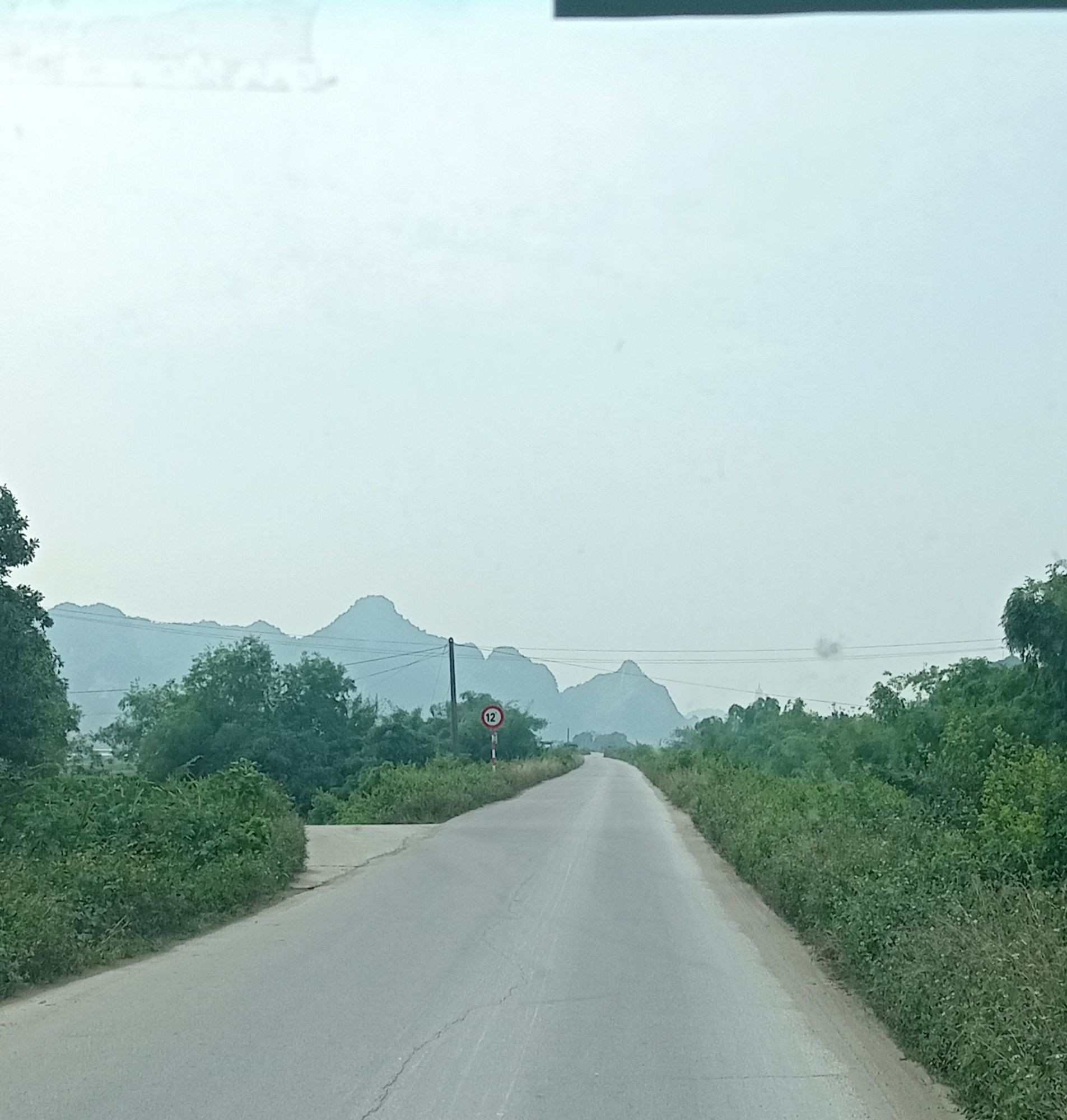 Approaching the Bai Dinh Complex. Stunning silhouettes of mountains in the distance.
Approaching the Bai Dinh Complex. Stunning silhouettes of mountains in the distance.
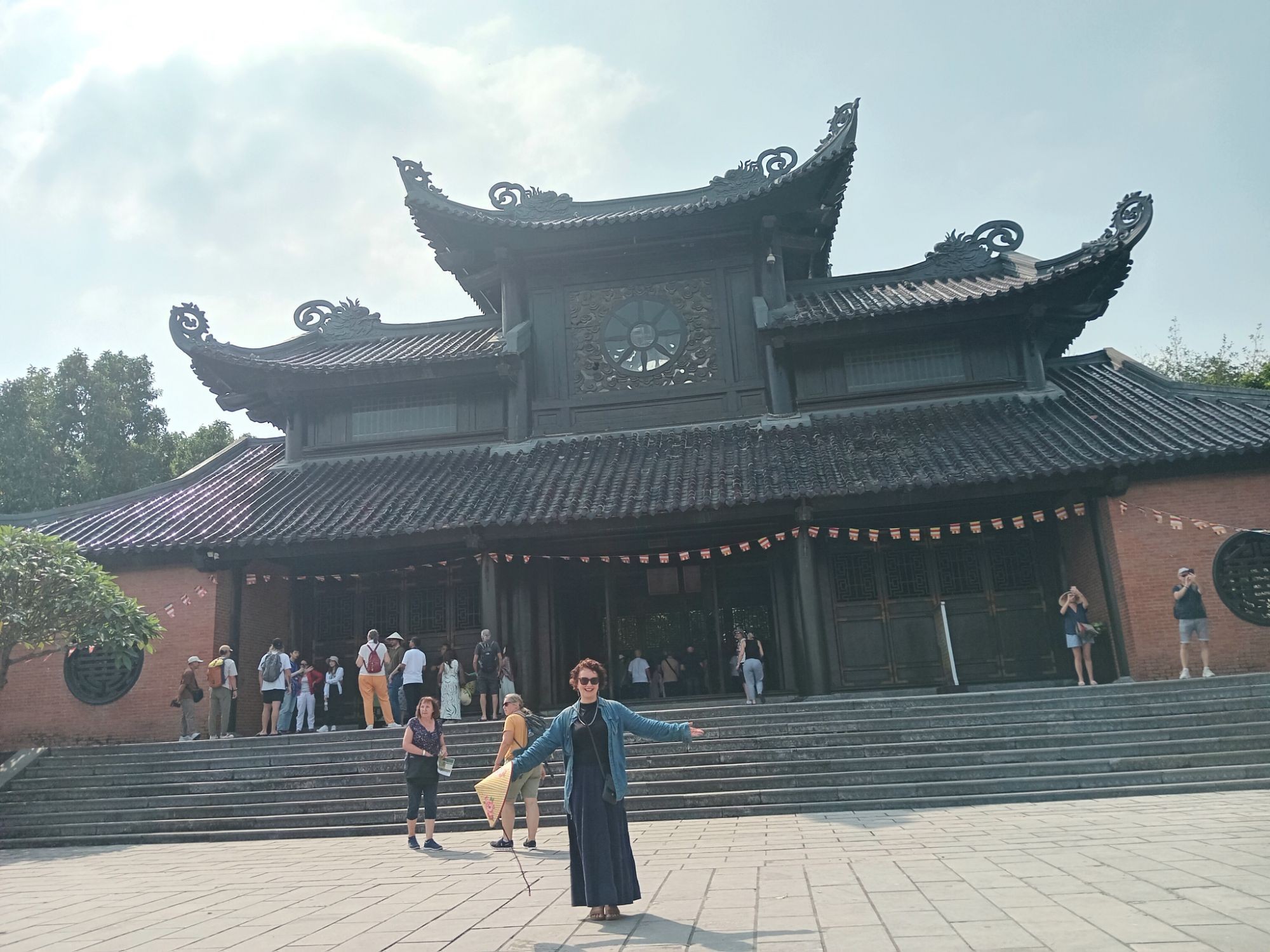 Adele Tomlin reaching the Bai Dinh temple complex.
Adele Tomlin reaching the Bai Dinh temple complex.
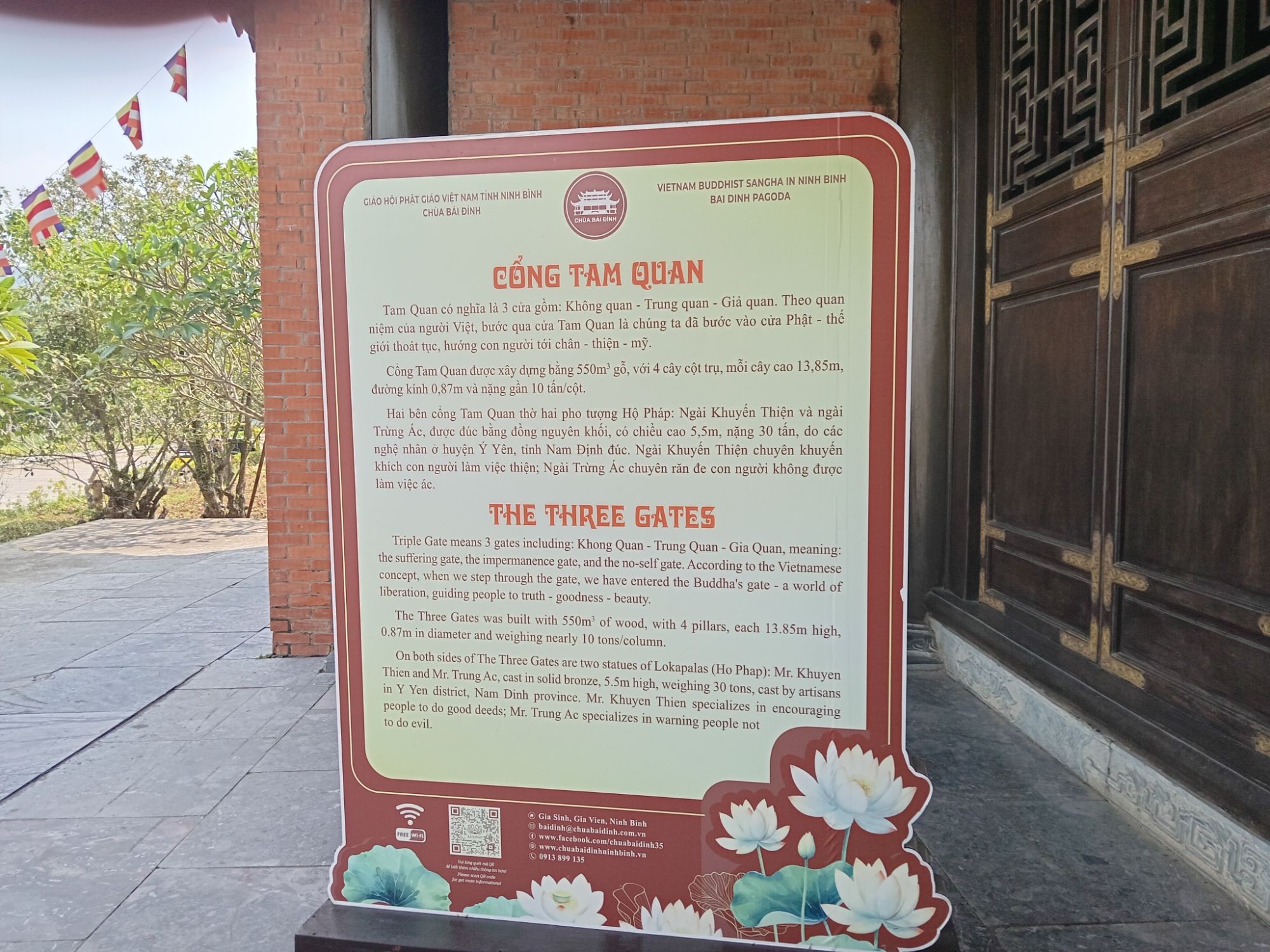 Explanation of the Three Gates at the Bai Dinh temple complex.
Explanation of the Three Gates at the Bai Dinh temple complex.
 One of the guardians at the entrance to the 500 Arhat corridor, Bai Dinh temple complex.
One of the guardians at the entrance to the 500 Arhat corridor, Bai Dinh temple complex.
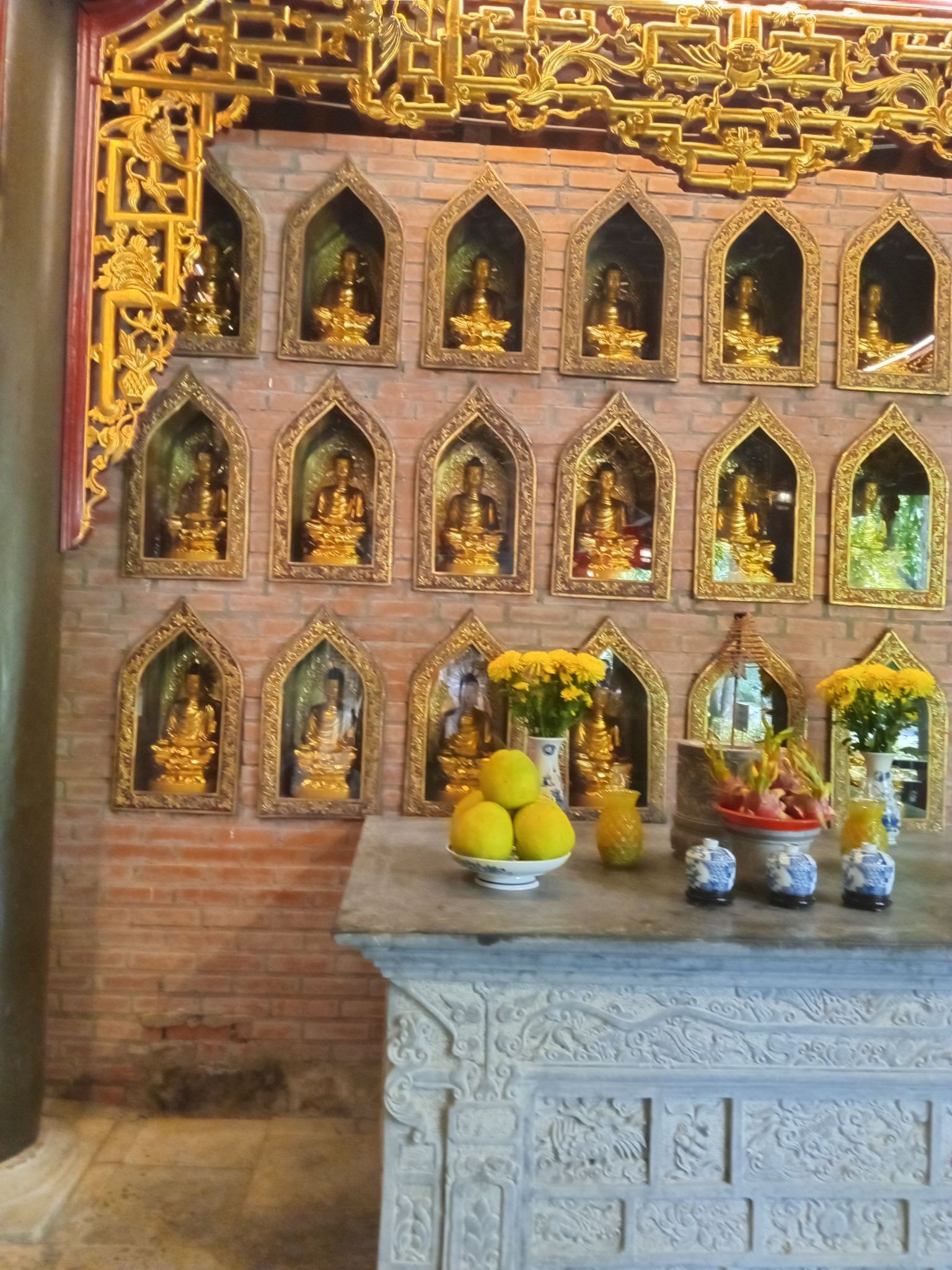 Buddhas at the Bai Dinh temple complex.
Buddhas at the Bai Dinh temple complex.
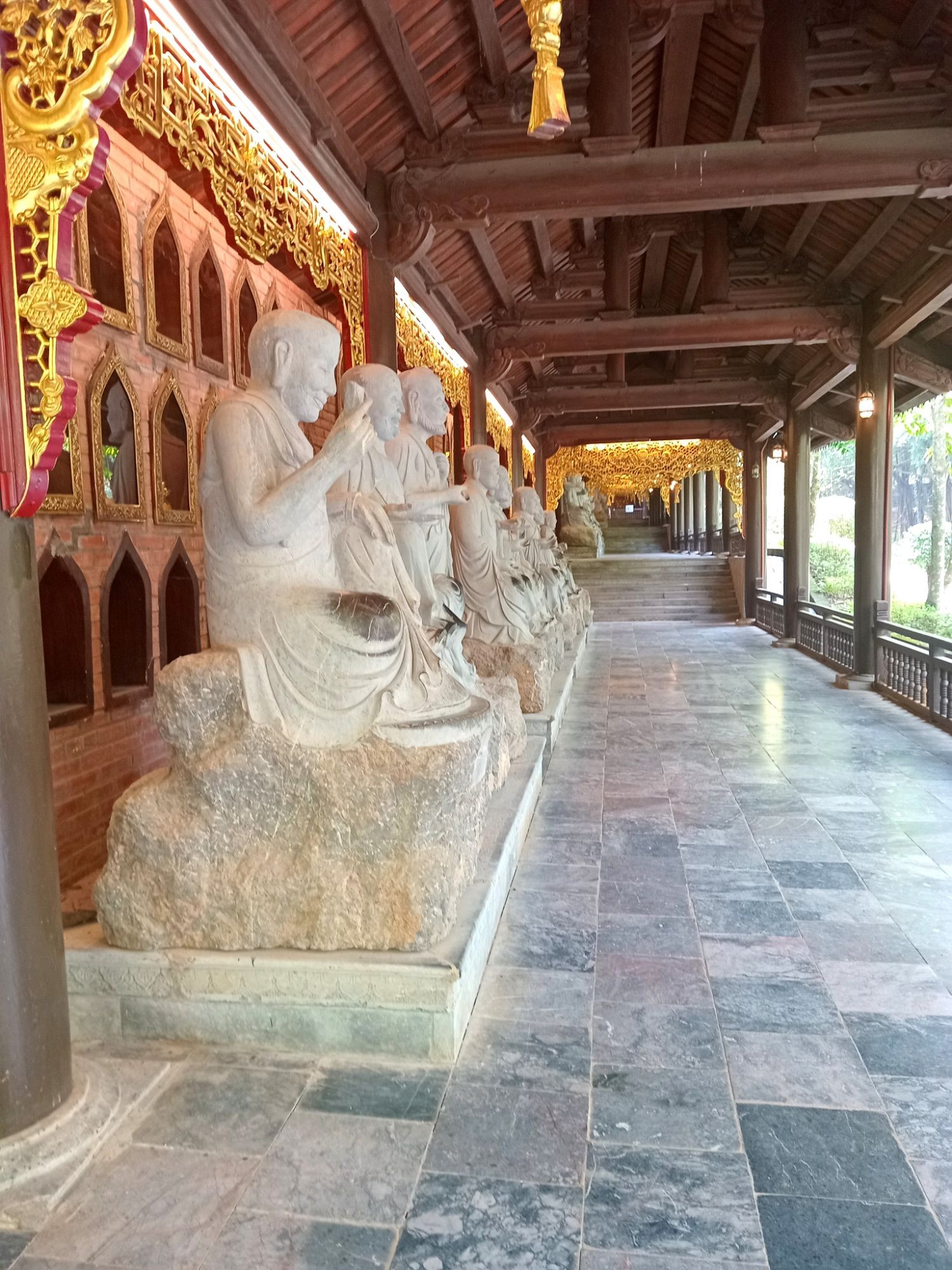 The stunning 500 Arhat Statues corridor at Bai Dinh complex.
The stunning 500 Arhat Statues corridor at Bai Dinh complex.
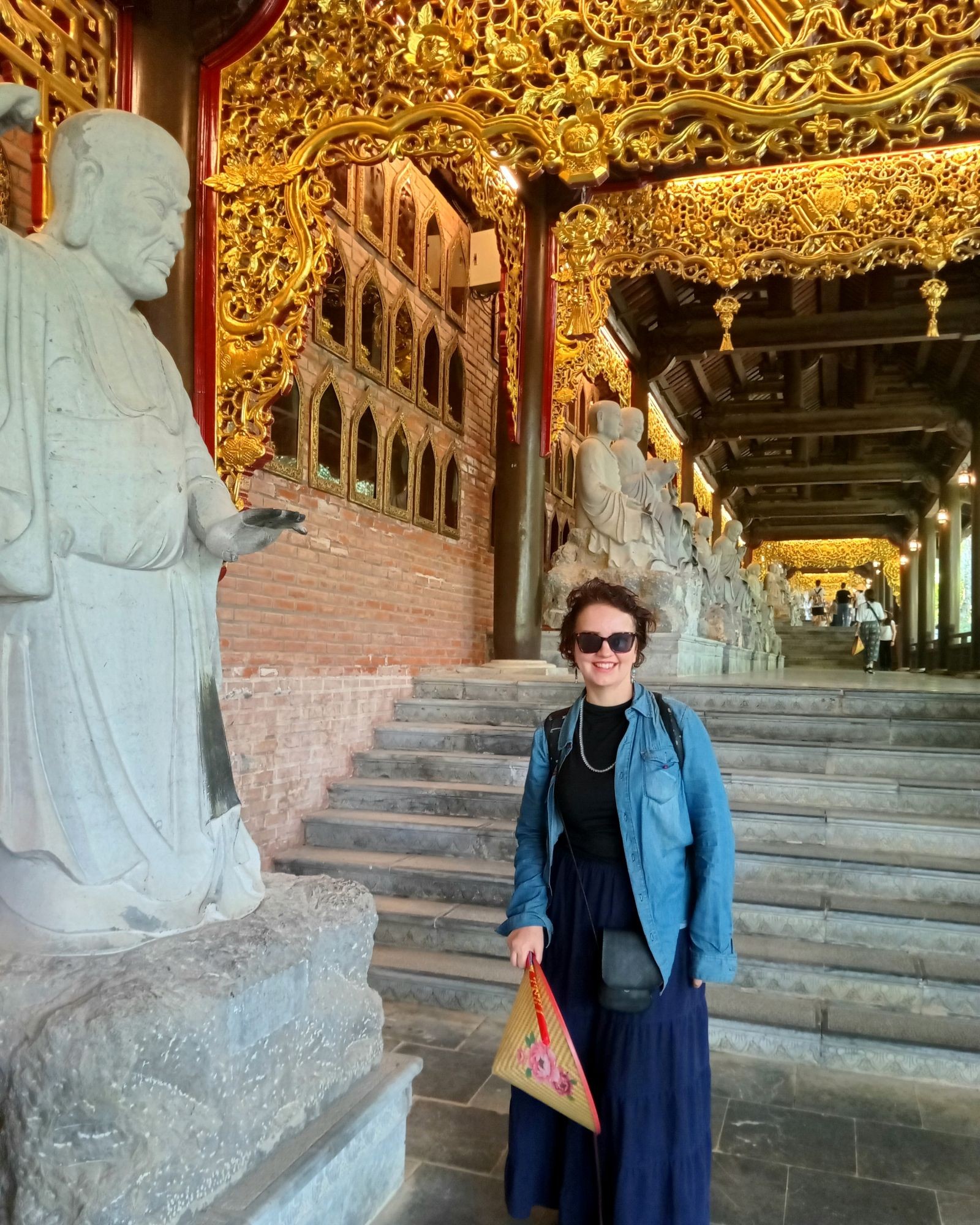 Adele Tomlin at the stunning 500 Arhat Statues corridor at Bai Dinh complex. Photo: November 2024.
Adele Tomlin at the stunning 500 Arhat Statues corridor at Bai Dinh complex. Photo: November 2024.
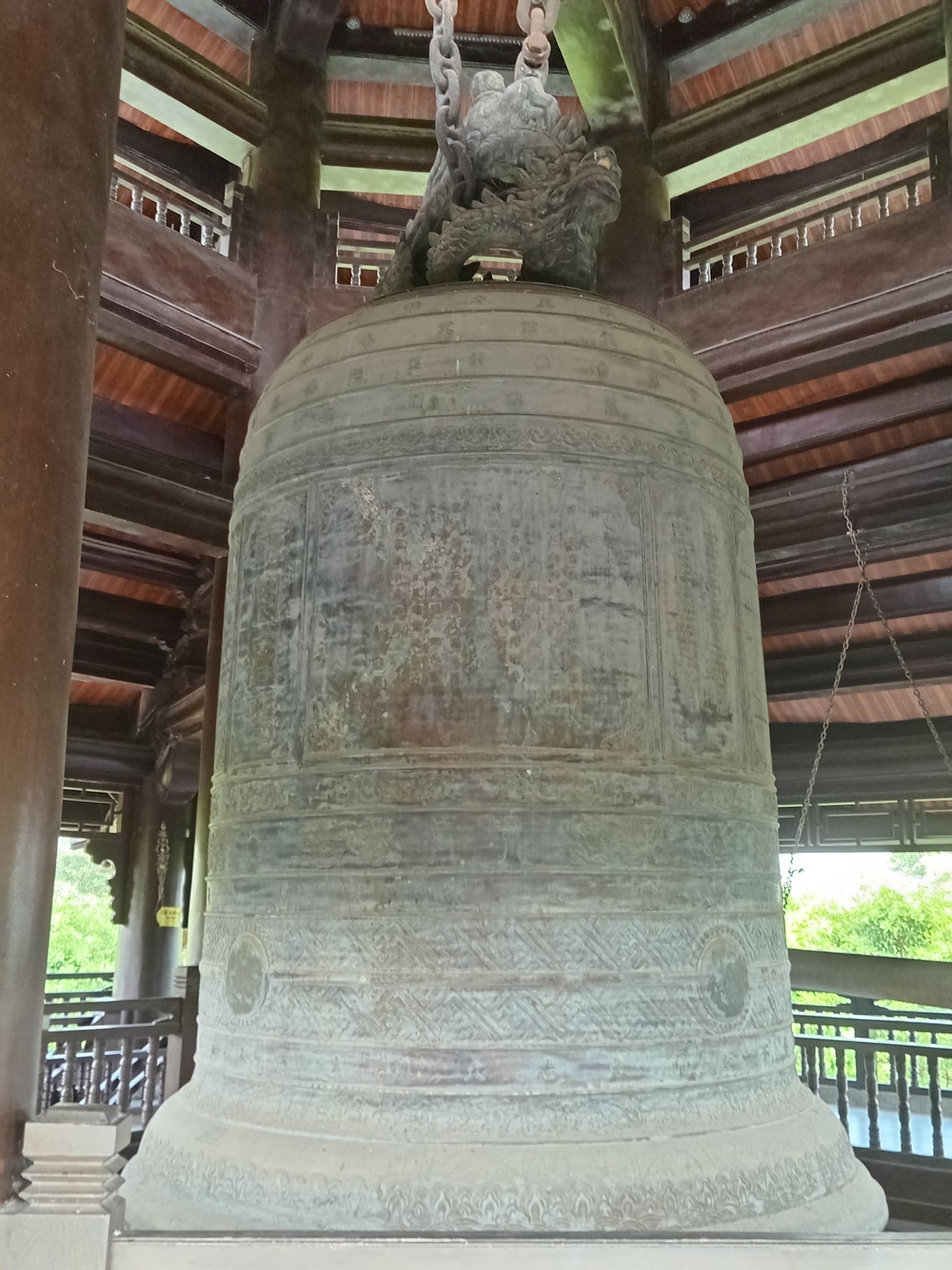 Huge bell at Bai Dinh complex.
Huge bell at Bai Dinh complex.
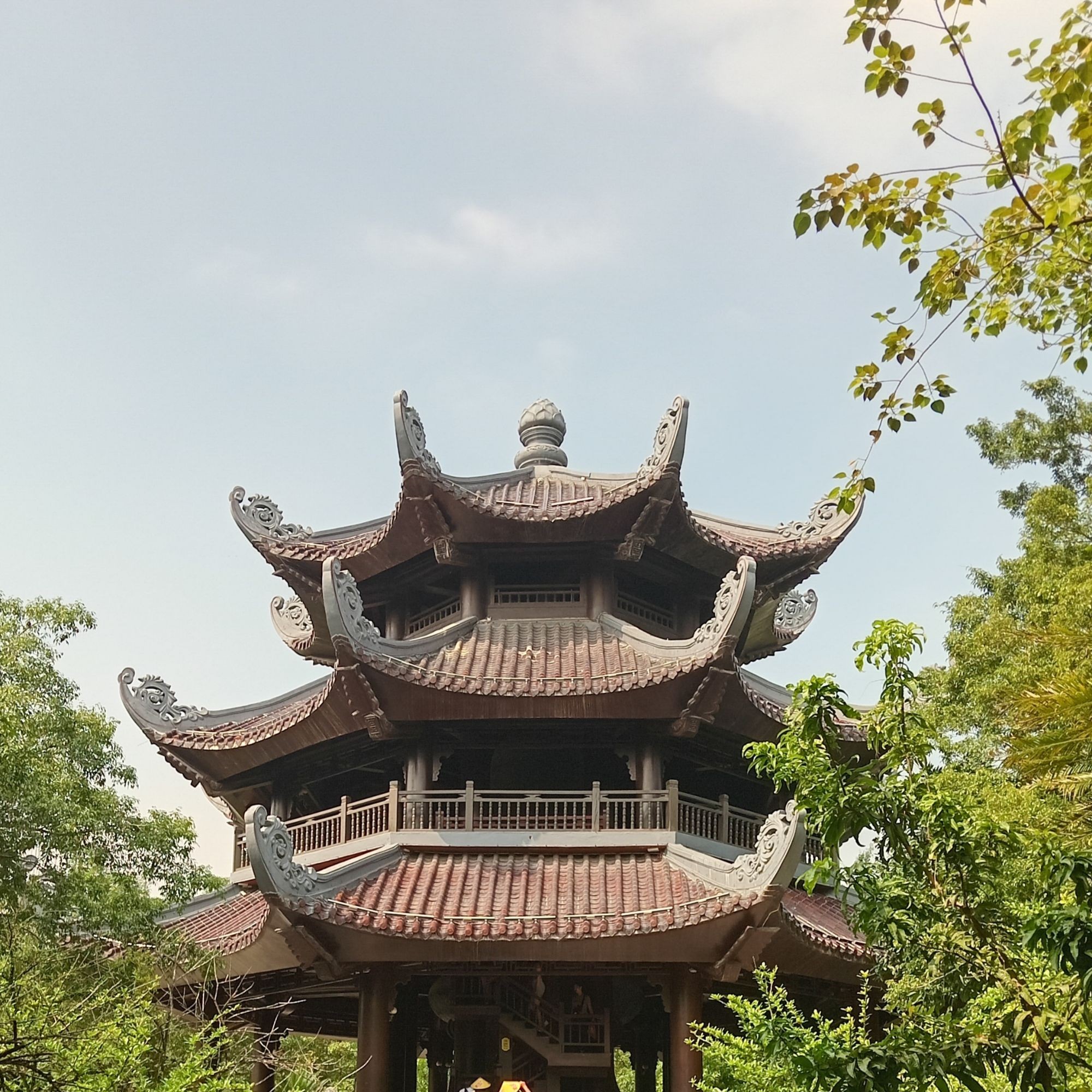 Bell-tower at Bai Dinh complex.
Bell-tower at Bai Dinh complex.
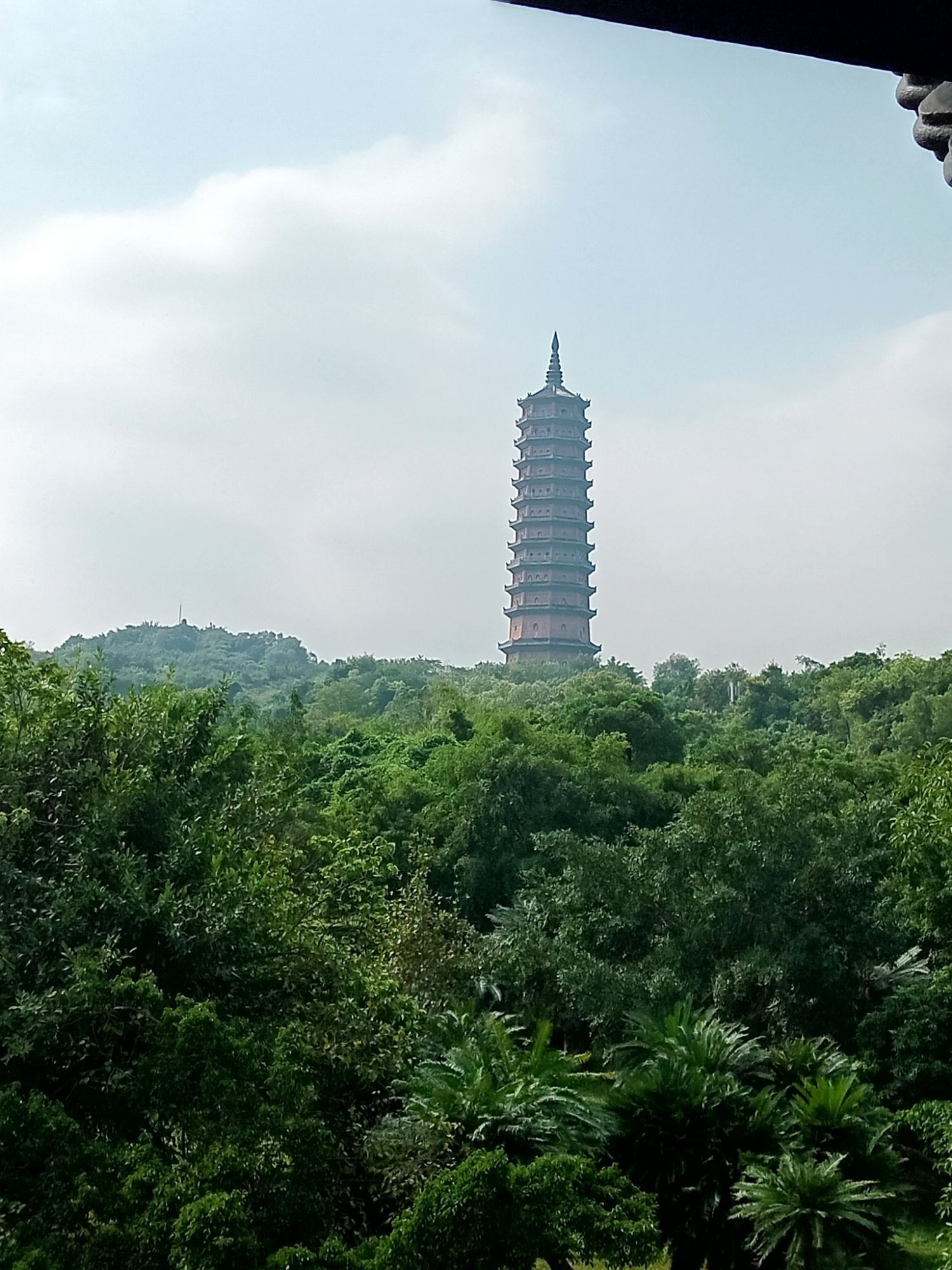 View of the huge relics stupa from the bell-tower at Bai Dinh complex.
View of the huge relics stupa from the bell-tower at Bai Dinh complex.
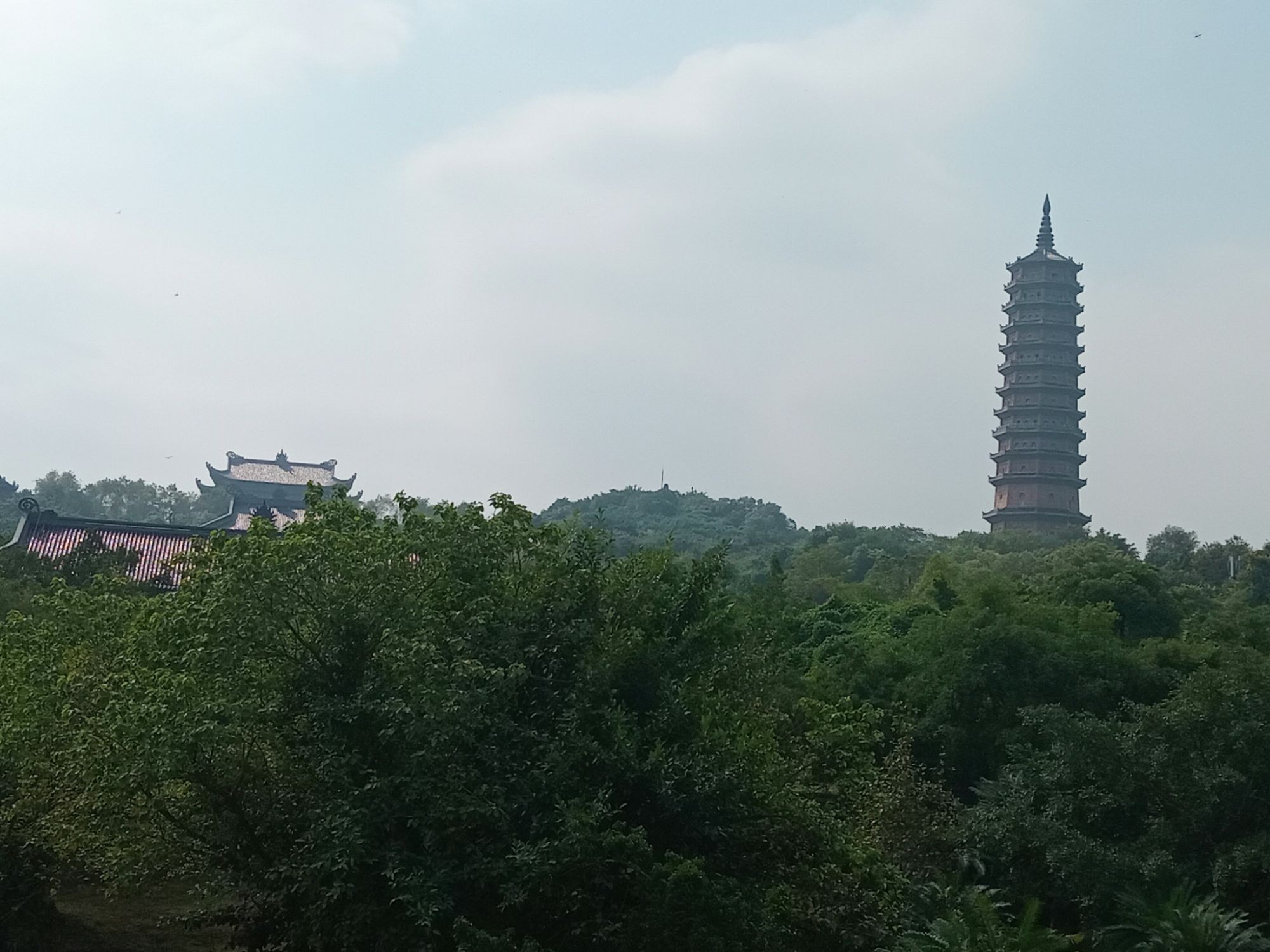 View of the huge relics stupa from the bell-tower at Bai Dinh complex.
View of the huge relics stupa from the bell-tower at Bai Dinh complex.
 Thousand-armed and thousand-eyed Mother of Compassion statue at the Bai Dinh complex.
Thousand-armed and thousand-eyed Mother of Compassion statue at the Bai Dinh complex.
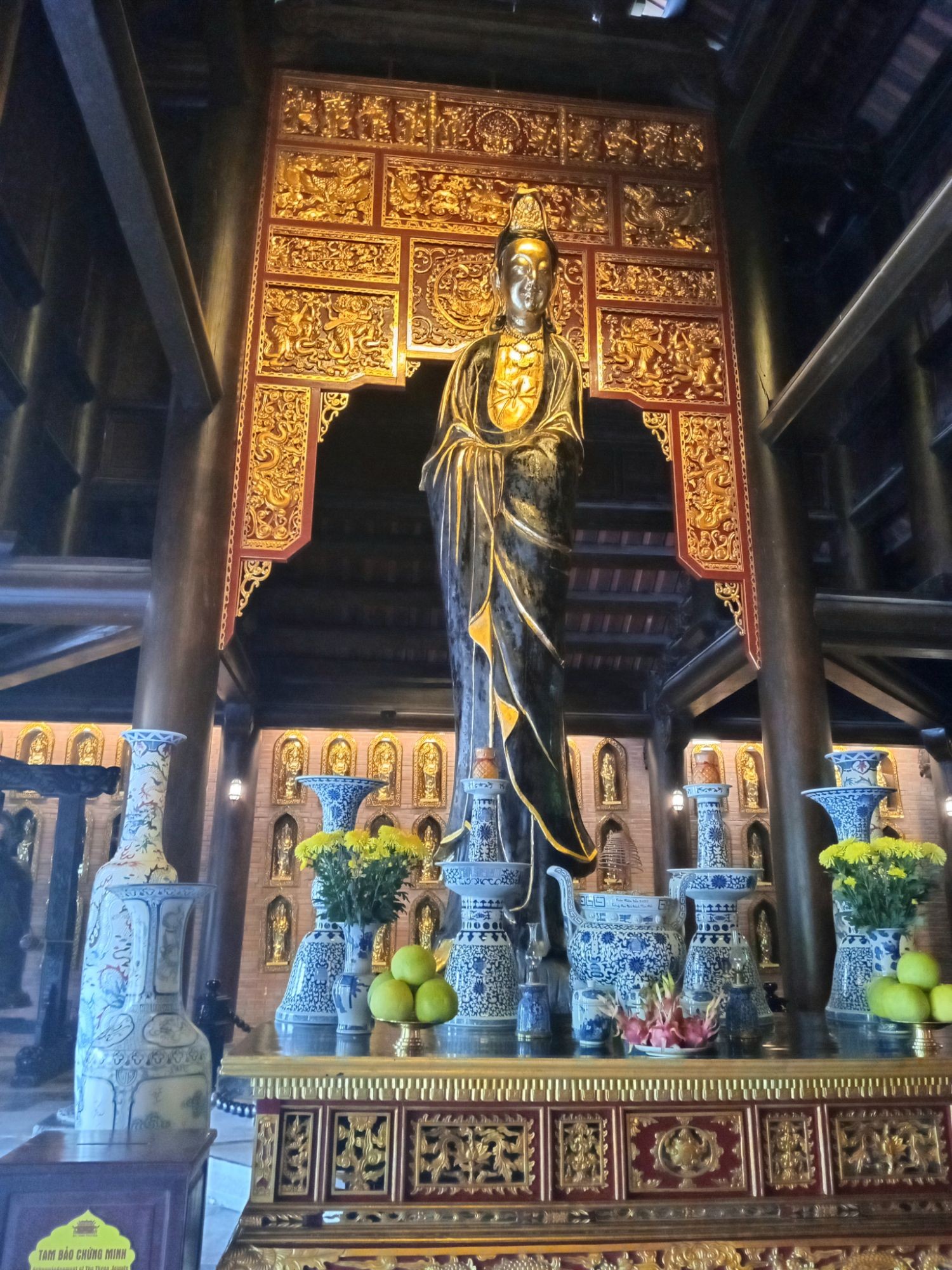 One of the two single faced and two armed Mother of Compassion (Quan Am) statues made from monolithic wooden trees, with both tree roots and tree tops.
One of the two single faced and two armed Mother of Compassion (Quan Am) statues made from monolithic wooden trees, with both tree roots and tree tops.
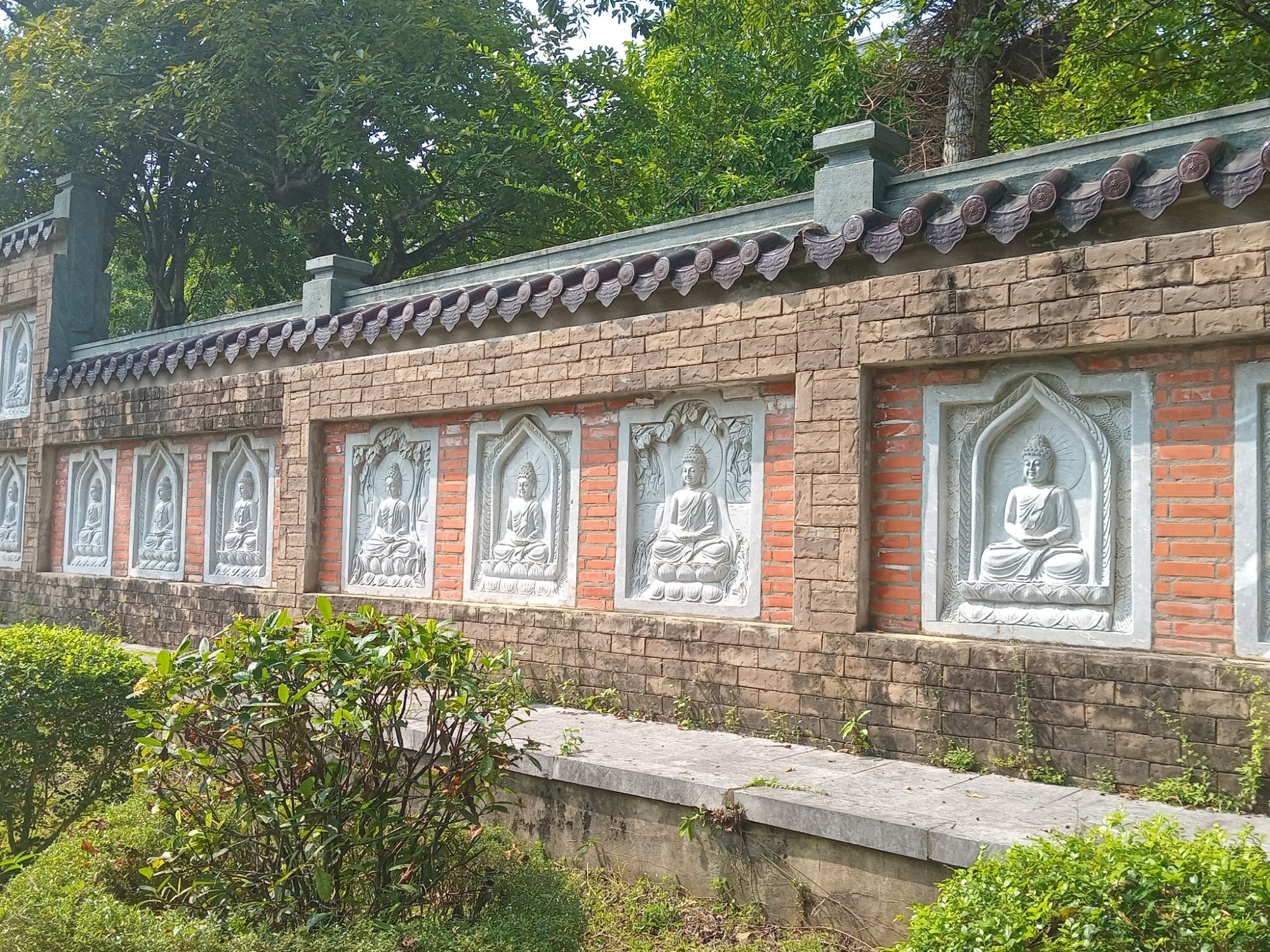 Walking via the Buddhist or Taoist route to the Buddha Shakyamuni Temple
Walking via the Buddhist or Taoist route to the Buddha Shakyamuni Temple
 Buddha Shakyamuni Statue, Bai Dinh complex.
Buddha Shakyamuni Statue, Bai Dinh complex.
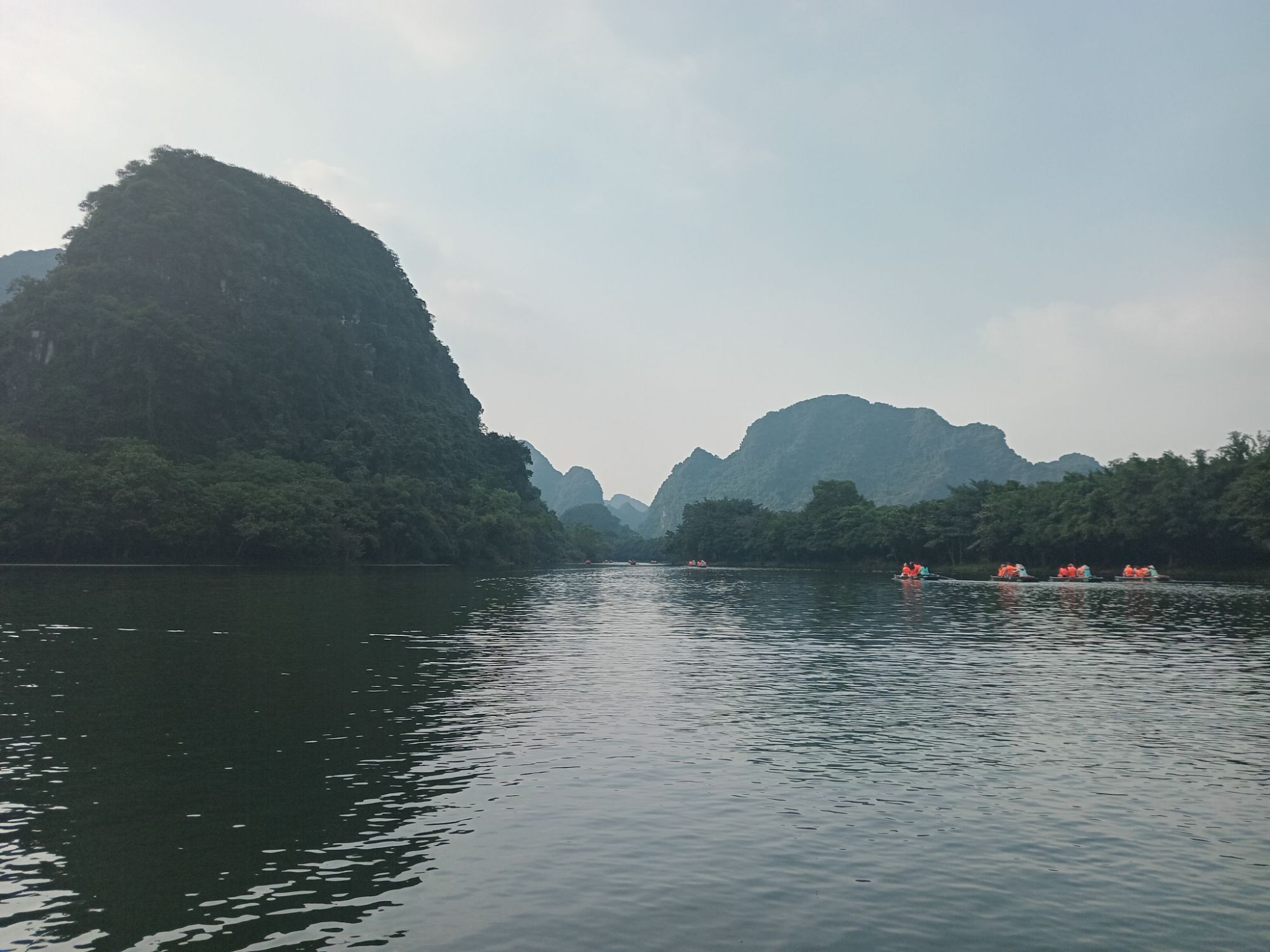 Spectacular mountain scenes and silhouettes around Trang An.
Spectacular mountain scenes and silhouettes around Trang An.
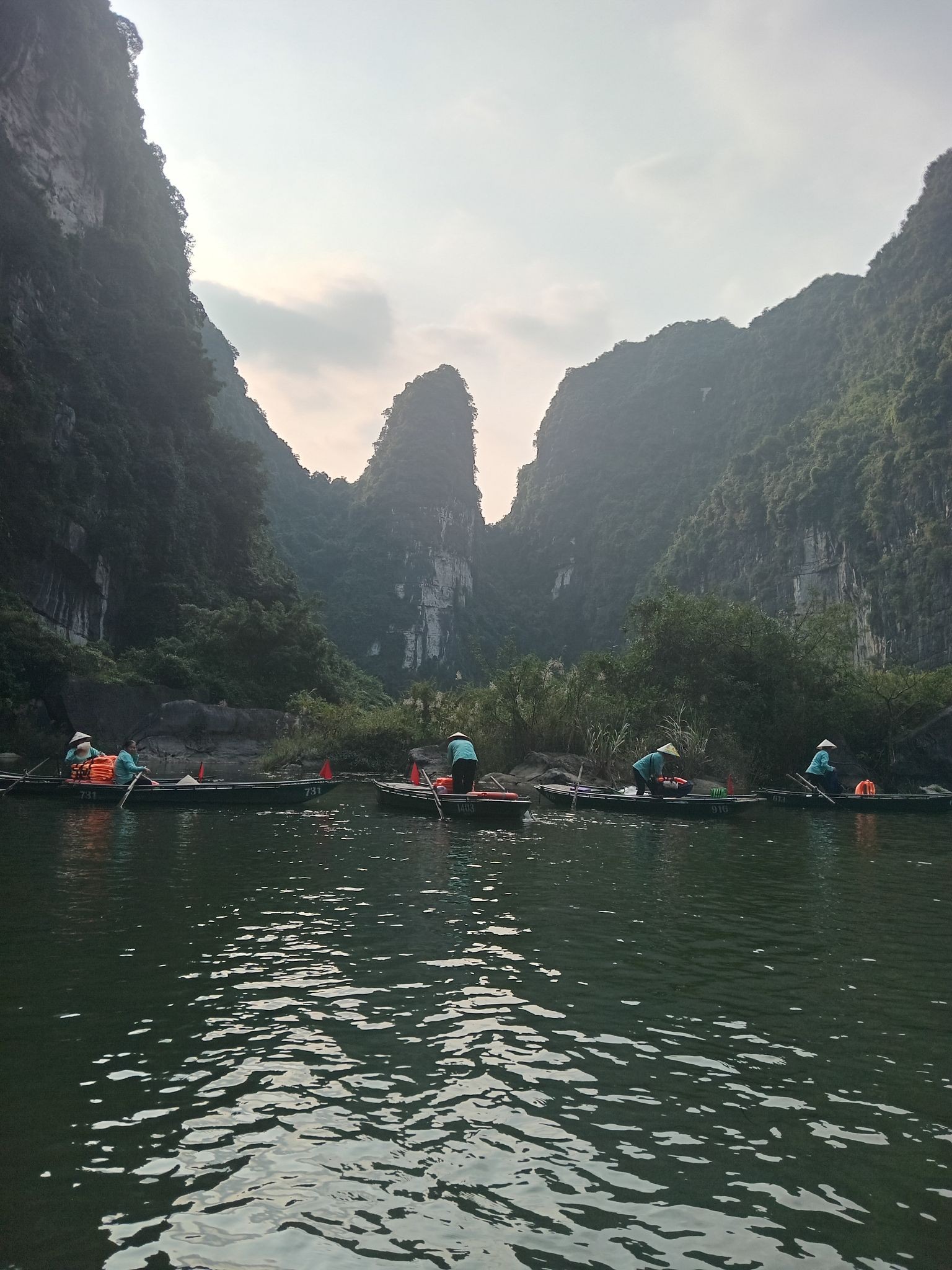 The amazing Vietnamese women boat rowers and spectacular mountain scenes and silhouettes around Trang An.
The amazing Vietnamese women boat rowers and spectacular mountain scenes and silhouettes around Trang An.
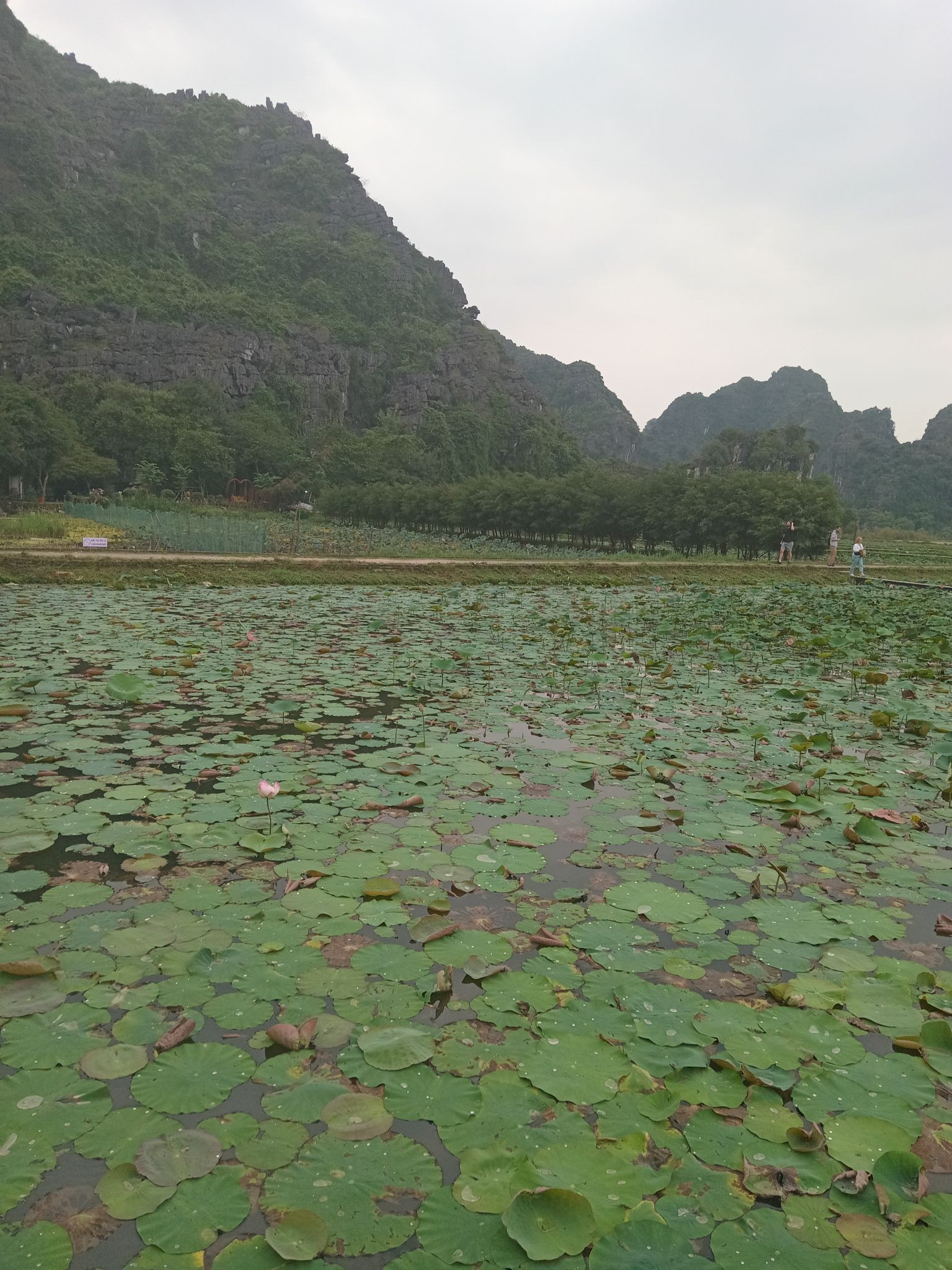 Lotus Lake below the Mua Cave Mountain.
Lotus Lake below the Mua Cave Mountain.



